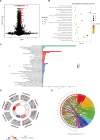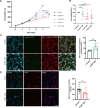Tamibarotene promotes differentiation of neuroblastoma SH-SY5Y cells into neurons, which is associated with activation of the PI3K/AKT signaling pathway
- PMID: 40665231
- PMCID: PMC12265314
- DOI: 10.1186/s12868-025-00962-8
Tamibarotene promotes differentiation of neuroblastoma SH-SY5Y cells into neurons, which is associated with activation of the PI3K/AKT signaling pathway
Abstract
Tamibarotene, a synthetic retinoid used in the treatment of acute promyelocytic leukemia, has been reported to induce differentiation in the SH-SY5Y cell line into neurons. However, the underlying mechanisms remain unclear. This study aimed to determine the optimal concentration of Tamibarotene (Am80) for promoting neuronal differentiation and to elucidate the underlying molecular mechanisms. SH-SY5Y cells were treated with Am80 at various concentrations, and the effects on cell morphology, gene expression, cell proliferation and apoptosis assessed using immunofluorescence, Western blotting, qPCR, and RNA sequencing. Results indicated that that 1µM Am80 effectively promoted neuronal differentiation, upregulating neuronal markers and the KCNT1 gene, while downregulating tumor-related genes MYC and CXCR4. The differentially expressed genes are predominantly enriched in the PI3K-Akt signaling pathway, with upregulation of genes related to neuronal development such as NTRK2, RET, and CNR1, and downregulation of tumor-related genes including MYC and CXCR4. Inhibition of the PI3K/Akt signaling pathway using LY294002 resulted in a decreased efficacy of AM80-induced differentiation in SH-SY5Y cells, along with downregulation of neuronal marker expression. These findings suggest that Am80 can effectively promote the differentiation of SH-SY5Y cells into neurons and reduce the proliferation of neuroblastoma cells, which is related to the PI3K/AKT pathway, providing a good model for the study of nervous system diseases.
Keywords: KCNT1; Cell differentiation; PI3K/Akt signaling pathway; SH-SY5Y; Tamibarotene.
© 2025. The Author(s).
Conflict of interest statement
Declarations. Ethics approval and consent to participate: Not applicable. In this study, the human neuroblastoma cell line SH-SY5Y (RRID: CVCL_0019) was used. According to the Guidelines for Exemption of Ethical Review from the Medical Research Ethics Committee, ethical review exemption is applicable. Consent for publication: Not applicable. Competing interests: The authors declare no competing interests.
Figures





Similar articles
-
Bexarotene Promotes Neuroblastoma SH-SY5Y Cell Differentiation to Mature Neurons with Decreased Proliferation.Mol Neurobiol. 2025 Aug;62(8):10670-10686. doi: 10.1007/s12035-025-04888-4. Epub 2025 Apr 14. Mol Neurobiol. 2025. PMID: 40229457
-
PTEN inhibition induces neuronal differentiation and neuritogenesis in SH-SY5Y cells via AKT signaling pathway.J Alzheimers Dis. 2025 Aug;106(4):1436-1451. doi: 10.1177/13872877251352194. Epub 2025 Jul 1. J Alzheimers Dis. 2025. PMID: 40598859
-
Combining network pharmacology and RNA sequencing to reveal the mechanism of emodin for the treatment of human neuroblastoma.Naunyn Schmiedebergs Arch Pharmacol. 2025 Aug;398(8):10093-10109. doi: 10.1007/s00210-025-03865-x. Epub 2025 Feb 13. Naunyn Schmiedebergs Arch Pharmacol. 2025. PMID: 39945814
-
The SH-SY5Y cell line in Parkinson's disease research: a systematic review.Mol Neurodegener. 2017 Jan 24;12(1):10. doi: 10.1186/s13024-017-0149-0. Mol Neurodegener. 2017. PMID: 28118852 Free PMC article.
-
Management of urinary stones by experts in stone disease (ESD 2025).Arch Ital Urol Androl. 2025 Jun 30;97(2):14085. doi: 10.4081/aiua.2025.14085. Epub 2025 Jun 30. Arch Ital Urol Androl. 2025. PMID: 40583613 Review.
References
-
- Stein EM, de Botton S, Cluzeau T, Pigneux A, Liesveld JL, Cook RJ, Rousselot P, Rizzieri DA, Braun T, Roboz GJ, et al. Use of tamibarotene, a potent and selective RARα agonist, in combination with Azacitidine in patients with relapsed and refractory AML with RARA gene overexpression. Leuk Lymphoma. 2023;64(12):1992–2001. - PubMed
-
- Xu C, Li J. Tamibarotene targets heparin-binding protein for attenuating lung injury in sepsis. Allergol Immunopathol(Madr). 2023;51(4):124–30. - PubMed
-
- Lopez-Suarez L, Awabdh SA, Coumoul X, Chauvet C. The SH-SY5Y human neuroblastoma cell line, a relevant in vitro cell model for investigating neurotoxicology in human: focus on organic pollutants. Neurotoxicology. 2022;92:131–55. - PubMed
MeSH terms
Substances
Grants and funding
- 2020YFA0804000/National Key Research and Development Program of China
- 2020YFA0804000/National Key Research and Development Program of China
- 2020YFA0804000/National Key Research and Development Program of China
- 2020YFA0804000/National Key Research and Development Program of China
- 2020YFA0804000/National Key Research and Development Program of China
- 2020YFA0804000/National Key Research and Development Program of China
- 2020YFA0804000/National Key Research and Development Program of China
- 2020YFA0804000/National Key Research and Development Program of China
- 82171435, 81971211, 81601131/National Natural Science Foundation of China
- 82171435, 81971211, 81601131/National Natural Science Foundation of China
- 82171435, 81971211, 81601131/National Natural Science Foundation of China
- 82171435, 81971211, 81601131/National Natural Science Foundation of China
- 82171435, 81971211, 81601131/National Natural Science Foundation of China
- 82171435, 81971211, 81601131/National Natural Science Foundation of China
- 82171435, 81971211, 81601131/National Natural Science Foundation of China
- 82171435, 81971211, 81601131/National Natural Science Foundation of China
- 7212109/Beijing Natural Science Foundation
- 7212109/Beijing Natural Science Foundation
- 7212109/Beijing Natural Science Foundation
- 7212109/Beijing Natural Science Foundation
- 7212109/Beijing Natural Science Foundation
- 7212109/Beijing Natural Science Foundation
- 7212109/Beijing Natural Science Foundation
- 7212109/Beijing Natural Science Foundation
- NCRCCHD-2021-KP-02/Key Project of Clinical Medicine Research of National Clinical Research Center for Child Health and Disorders, Children's Hospital of Chongqing Medical University
- NCRCCHD-2021-KP-02/Key Project of Clinical Medicine Research of National Clinical Research Center for Child Health and Disorders, Children's Hospital of Chongqing Medical University
- NCRCCHD-2021-KP-02/Key Project of Clinical Medicine Research of National Clinical Research Center for Child Health and Disorders, Children's Hospital of Chongqing Medical University
- NCRCCHD-2021-KP-02/Key Project of Clinical Medicine Research of National Clinical Research Center for Child Health and Disorders, Children's Hospital of Chongqing Medical University
- NCRCCHD-2021-KP-02/Key Project of Clinical Medicine Research of National Clinical Research Center for Child Health and Disorders, Children's Hospital of Chongqing Medical University
- NCRCCHD-2021-KP-02/Key Project of Clinical Medicine Research of National Clinical Research Center for Child Health and Disorders, Children's Hospital of Chongqing Medical University
- NCRCCHD-2021-KP-02/Key Project of Clinical Medicine Research of National Clinical Research Center for Child Health and Disorders, Children's Hospital of Chongqing Medical University
- NCRCCHD-2021-KP-02/Key Project of Clinical Medicine Research of National Clinical Research Center for Child Health and Disorders, Children's Hospital of Chongqing Medical University
- 2020-1-4071/Capital Health Research and Development of Special Fund
- 2020-1-4071/Capital Health Research and Development of Special Fund
- 2020-1-4071/Capital Health Research and Development of Special Fund
- 2020-1-4071/Capital Health Research and Development of Special Fund
- 2020-1-4071/Capital Health Research and Development of Special Fund
- 2020-1-4071/Capital Health Research and Development of Special Fund
- 2020-1-4071/Capital Health Research and Development of Special Fund
- 2020-1-4071/Capital Health Research and Development of Special Fund
- BZ0317/Beijing Key Laboratory of Molecular Diagnosis and Study on Pediatric Genetic Diseases
- BZ0317/Beijing Key Laboratory of Molecular Diagnosis and Study on Pediatric Genetic Diseases
- BZ0317/Beijing Key Laboratory of Molecular Diagnosis and Study on Pediatric Genetic Diseases
- BZ0317/Beijing Key Laboratory of Molecular Diagnosis and Study on Pediatric Genetic Diseases
- BZ0317/Beijing Key Laboratory of Molecular Diagnosis and Study on Pediatric Genetic Diseases
- BZ0317/Beijing Key Laboratory of Molecular Diagnosis and Study on Pediatric Genetic Diseases
- BZ0317/Beijing Key Laboratory of Molecular Diagnosis and Study on Pediatric Genetic Diseases
- BZ0317/Beijing Key Laboratory of Molecular Diagnosis and Study on Pediatric Genetic Diseases
- BMU2017JI002, BMU2018XY006, PKU2017LCX06/Fundamental Research Funds for the Central Universities
- BMU2017JI002, BMU2018XY006, PKU2017LCX06/Fundamental Research Funds for the Central Universities
- BMU2017JI002, BMU2018XY006, PKU2017LCX06/Fundamental Research Funds for the Central Universities
- BMU2017JI002, BMU2018XY006, PKU2017LCX06/Fundamental Research Funds for the Central Universities
- BMU2017JI002, BMU2018XY006, PKU2017LCX06/Fundamental Research Funds for the Central Universities
- BMU2017JI002, BMU2018XY006, PKU2017LCX06/Fundamental Research Funds for the Central Universities
- BMU2017JI002, BMU2018XY006, PKU2017LCX06/Fundamental Research Funds for the Central Universities
- BMU2017JI002, BMU2018XY006, PKU2017LCX06/Fundamental Research Funds for the Central Universities
LinkOut - more resources
Full Text Sources
Medical

